Sold Ceramics
Sold Ceramics - Sold Chine de commande - Western Subjects 1680-1800 - Western Designers -
Page 1
Pronk, Cornelis (1691-1759)
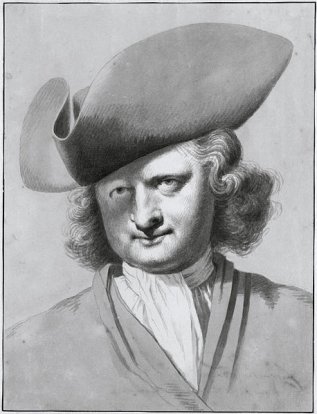
Pronk, Cornelis (1691-1759)
From 1700 onwards, Chinese porcelain with Western depictions became highly in demand. This so-called Chine de commande was made to order for private Western traders, which earned them a lot of money. The Dutch East India Company, (Vereenigde Oost-Indische Compagnie, VOC), which had started to actively purchase porcelain in Canton after 1728, also wanted to get in on this specific trade. In 1734, as an experiment, the Dutch East India Company board, the Heren XVII, commissioned the Amsterdam artist Cornelis Pronk (1691-1759) to design depictions for services and other porcelains. He then designed a chinoiserie, a depiction in Chinese style, featuring a Chinese lady at the waterside and a female servant holding an umbrella. These drawings with the designs, which are now known as the Parasoldames (the parasol ladies) were sent to Batavia and from there to China, where porcelain, decorated after this example, was ordered in 1736. The coloured drawn plate design has been preserved and is now part of the collection of the Rijksmuseum Amsterdam. The High Government ordered porcelain conform to these drawings in both China and Japan.
Pronk Porselein was manufactured in three versions: in Imari, overglaze enamels as well as in underglaze blue. It was very well received in the Netherlands, however production costs in China proved to be so high that sales earned a minimum profit, which soon caused the Dutch Ears India Company to cease the commissioning of this type of porcelain. Besides the Parasoldames Pronk also drew other drafts: the Vier Doktoren (the four doctors), the Prieel (the arbour) and the Handwassing (hand-washing). Chinese porcelain was manufactured to order after these drawings as well, however its production was later also ceased because it proved to be costly as well. (Source: Groninger Museum)
The 'Parasol Lady', 1736
The 'Parasol Lady' was the first design sent to Batavia in 1736. The High Government ordered porcelain conform to these drawings in both China and Japan. There are different varieties done in Imari, overglaze enamels as well as in underglaze blue.
Pronk’s original design shows a lady standing at the water's edge, who is making a gesture with her hands towards three birds on the ground in front of her. On the right, obliquely behind her, stands a maid servant holding an ornate parasol. Interestingly, two of the birds are identified as the ruff (Dutch: kemphaan) and the spoonbill (Dutch: lepelaar), both of which are native to Holland.
Pronk’s design source(s) are not known. But already in the early seventeenth century the parasol was used in European chinoiserie designs as a depiction of the exotic life in the Far East. Figures wearing robes and with an umbrella can also be found in patterns of the famous chinoiserie designer Johann Gregor Höroldt (1696-1775) of the Meissen Factory. Parasols have been known in China for more than 2000 years and are included in the eight Buddhist symbols. Being held above the head of an official, it is emblematic of rank. The Umbrella of Ten Thousand People is also considered a symbol of dignity and high rank and a token of respect and purity. The Daoist Queen of the West, Hsi Wang Mu, is usually depicted with one or two servants holding a fan or parasol. She may also be accompanied by a crane and peaches, both representing eternal life. Another possibility is that Pronk’s design was based on a Japanese source, perhaps a print (ukiyo-e). Women with parasols were a popular subject for the Japanese artists.
This particular Pronk design enjoyed great popularity. It is the only Pronk drawing of which various examples exist in Chinese as well as Japanese porcelain.
As mentioned Pronk's design of the 'Parasol Lady' was also used on Japanese porcelain. It was not ordered by the Dutch East India Company, (Vereenigde Oost-Indische Compagnie, VOC) but commioned by private Dutch traders. On Japanese pieces, the Chinese ladies have become Japanese with their characterristic hairstyles and kimonos. Pronk designs were still in great demand, particularly the Parasol Lady, when VOC orders for this type of porcelain declined. Simplified versions were made at the artists' initiative, where both early Chinese and Japanese versions were used as models. (Jörg 2002/2, pp.144-145)
In Chinese porcelain there are even interpretations of the design by the Chinese porcelain painters themselves, maybe meant for the own domestic market as an exotic item, an 'Europeanerie'. In this case the left lady is replaced by a little boy (‘zotje’ ). Furthermore, the design was also widely copied in Europe, for example by the Venetian Porcelain Factory Cozzi, the Dutch Ouder-Amstel Porcelain Factory and also by Delft factories. At Delft, there were plain white objects decorated with the Chinese version of the Parasol Ladies. Until the mid to late 19th century the pattern of the 'Parasol Lady' was still used on European porcelain, for example at the famous Herendt Factory in Hungary and at the Porcelain Factory of Maastricht, the Netherlands
Even more unique, recently a thus far unrecorded clobbered or Amsterdam Bont overdecorated pair of bowls was discovered, were the Delft painter didn’t quite respect the original underglaze blue 'Parasol Lady' design, please see:

old Ceramics - Sold Chine de commande - Western Subjects 1680-1800 - Western Designers -
Page 1
Pronk, Cornelis (1691-1759)
Object 2011469
Tea caddy
China
1736-1738
Height with cover 125 mm (4.92 inch), height without cover 91 mm (3.58 inch), diameter 70 mm (2.76 inch), diameter of rim 29 mm (1.14 inch), diameter of footring 45 mm (1.77 inch)
Tea caddy of ovoid form on a footring, domed cover with a pointed knob. Applied scroll work at the spreading foot. Decorated in underglaze blue with the 'Parasol Lady' after a design by the Dutch artist Cornelis Pronk (1691-1759) with a lady besides the water's edge with reeds, gesturing towards three birds on the ground in front of her, and her maid holding an ornate parasol. Round the shoulder a border with flower heads alternating with leafy scrolls. On the cover a honeycomb pattern and cartouches filled with a paddling bird.
In total only four underglaze blue tea services were ordered by the VOC. The records of the VOC didn’t specify the component parts of these tea sets. However, usually one or sometimes two tea caddies were part of a tea service, which would mean there probably only were four to maximum eight tea caddies made. This is only the second underglaze blue tea caddy has been recorded in literature thus far. However this one is complete where as the other one is missing it's cover. (Jörg 1982/1, pp. 188-189)
For other parts of an underglaze blue 'Parasol Lady' tea service, such as the coffeepot, teapot, sugar bowl etc., please see:
- Chine de Commande, (D.F. Lunsingh Scheurleer, Hilversum, 1966), cat. 185.
- China for the West. Chinese Porcelain and other Decorative Arts for Export illustrated from the Mottahedeh Collection, (D.S. Howard & J. Ayers, Philip Wilson Publishers for Sotheby Parke Bernet Publications, London 1978), vol. 1, p.298, cat. 291.
- Pronk porselein. Porselein naar ontwerpen van Cornelis Pronk / Pronk Porcelain. Porcelain after designs by Cornelis Pronk, (C.J.A. Jörg, exhibition catalogue, Groninger Museum / Haags Gemeentemuseum, Groningen, 1980), pp.64-65 cat. 13-18.
- 'De Parasoldame', C.J.A. Jörg in Kunstschrif, 1996-5, Den Haag, september / oktober 1996, p.40, fig. 80.
- Chinese Ceramics in the Collection of the Rijksmuseum, Amsterdam. The Ming and Qing Dynasties, (C.J.A. Jörg in collaboration with J. van Campen, London, 1997), p. 283 cat. 329
- Jan Menze van Diepen Stichting. Selectie uit de collectie Oosterse keramiek. (Jan Menze van Diepen Foundation. A Selection from the Collection of Oriental Ceramics), (C.J.A. Jörg, Slochteren, 2002), pp.143-144, cat. 98 & 99.
Condition: A glaze rough spot to the knob, a frit to the cover and a restored mouthrim.
References:
Goldsmith Phillips 1956, cat. 33
Lunsingh Scheurleer 1966, cat. 185
Howard & Ayers 1978, vol. I, cat. 291
Jörg 1982/1, cat. 31-35 & cat. 40
Lunsingh Scheurleer 1989, cat. 182
Howard 1994, cat. 53 & cat. 57
Jörg & Van Campen 1997, cat. 328a/b & cat. 329
Price: Sold.

Sold Ceramics - Sold Chine de commande - Western Subjects 1680-1800 - Western Designers -
Page 1
Pronk, Cornelis (1691-1759)
Object 2010734
Dish
China
1736-1738
Height 32 mm (1.26 inch), diameter of rim 190 mm (7.48 inch), diameter of footring 115 mm (4.53 inch)
Dish on footring, straight underglaze brown-edged rim (jia mangkou). Chinese Imari, decorated in underglaze blue and overglaze iron-red and gold with the 'Parasol Lady' after a design by the Dutch artist Cornelis Pronk (1691-1759) with a lady besides the water's edge with reeds, gesturing towards three birds on the ground in front of her, and her maid holding an ornate parasol. On the sides flower heads alternating with leafy scrolls, on the rim a honeycomb pattern in four rows, four large cartouches with paddling birds repeated from the central scene, and four small cartouches with the ladies from the central scene. On the reverse seven insects in underglaze blue.
Dinner services, tea sets and other items with the 'Parasol Lady' were produced in underglaze blue, Chinese Imari and polychrome enamels and sent to the Netherlands in 1737 and 1738. (Jörg & Van Campen 1997 p.282)
A complicating factor in dating these iron-red pieces is the fact that the design was ordered again in the 1770s with the same colour scheme, and it is difficult to distinguish between the two groups unless the configuration of the central design or the form of the piece is clearly late 18th century.
For identically decorated dishes, please see:
- The Japanese porcelain trade of the Dutch East India Company after 1683, (T. Volker, Rijksmuseum voor Volkenkunde, E.J. Brill, Leiden 1959), Pl. XVIII, cat. 23a & Pl. XIX, cat. 24.
- China for the West. Chinese Porcelain and other Decorative Arts for Export illustrated from the Mottahedeh Collection, (D.S. Howard & J. Ayers, Philip Wilson Publishers for Sotheby Parke Bernet Publications, London 1978), vol. 1, pp.298-299, cat. 292.
- Pronk porselein. Porselein naar ontwerpen van Cornelis Pronk / Pronk Porcelain. Porcelain after designs by Cornelis Pronk, (C.J.A. Jörg, exhibition catalogue, Groninger Museum / Haags Gemeentemuseum, Groningen, 1980), p.66 cat.20 & p.73, cat III.
- Christie's pictorial history of Chinese ceramics, (A. du Boulay, Phaidon-Christie's, Oxford 1984), p.262, cat. 4.
- 'De Parasoldame', C.J.A. Jörg in Kunstschrif, 1996-5, Den Haag, september / oktober 1996, p.40, fig. 81.
- Chinese Export Porcelain in the Reeves Center Collection at Washington and Lee University, (Th. V. Litzenburg, London 2003), p.175, cat. 170.
- Kostbaar Goed van Grote Pracht. Chinees en Japans exportporselein uit de 17e en 18e eeuw, (Mr. L.C.A.M. Schölvinck, Zwolle 2010), p.53.
- Collecting Chinese and Japanese Porcelain in Pre-Revolutionary Paris, (S. Castelluccio, The J. Paul Getty Museum, Los Angeles 2013), p.128, Figure 107.
- Asian Ceramics in The Hallwyl Collection, (R. Kerr, The Hallwyl Museum, Stockholm, 2015), p.174 & pp.179-181, cat. 161.
Condition: Two firing fault spots to the centre and two hairlines to the rim.
References:
Goldsmith Phillips 1956, cat. 33
Volker 1959, Pl. XVIII, cat. 23a, & Pl. XIX, cat. 24
Lunsingh Scheurleer 1966, cat. 185
Howard & Ayers 1978, vol. I, cat. 292
Jörg 1982/1, cat. 31-35 & cat. 40
Lunsingh Scheurleer 1989, cat. 182
Howard 1994, cat. 53 & cat. 57
Jörg & Van Campen 1997, cat. 328a/b & cat. 329
Sargent 2012, p.183 & cat. 143
Price: Sold.
The 'Arbour', 1737
Cornelis Pronk made his fourth and last drawing for the Dutch East India Company (VOC) in 1737. Unfortunately, the original design has not been preserved. It was sent to Batavia by the Heeren XVII in 1738 and received in Canton in 1739. On the basis of pieces of porcelain still in existence it can be said that the subject of this drawing must have been the ‘Arbour’. The motif on this dish was already described for the first time by Jacquemart & le Blant in 1862, who called it a ‘mariage orientale.’ In its style, detailing and anecdotal character, this decoration is strongly reminiscent of Pronk’s earlier designs and it is generally accepted that it too is by him. Furthermore, its formal composition, with a combination of European and Oriental motifs arranged in a late baroque style, shows strong similarities with Pronk’s first design the Parasol Ladies (please see sold object 2010734), particularly in the depiction of the Chinoiserie ladies with delicate facial features and tall hair coiffures. The climbing roses depicted at either side of the arbour, and the centre right of this dish with scattered flowers among green leaves, are reminiscent of the flowers shown in the tree depicted at the right side of the ‘The Four Doctors’ design. The formal composition of the border around the well is also comparable to the elaborate borders of both ´The Four Doctors’ and ‘The Parasol Ladies’, particularly in the depiction of the birds and fishes and the dense trellis and honeycomb-pattern grounds.
Pronk’s immediate source of inspiration for the central composition of this design is not clear. There are late 17th century Frankfurt tin-glazed dishes, which may have been copied from Delft, decorated with a central scene of four figures seated in front of an arbour. The figures resemble the ‘The Four Doctor’s’ from Pronk’s second design, while the arbour is reminiscent to the one on Pronk's 'Arbour' dishes. Another related scene is found on a Dutch Delft dish, also dated late 17th century.
(left) Frankfurt, Germany, late 17th century, tin-glazed dish, D. 350 mm (13.77 inch), Troesch Collection, Switzerland. Reproduced from: M. Rinaldi. Kraak Porcelain. A Moment in the History of Trade, London 1989, , pp. 224-225 plate 285. (right) Sold Ceramics - Sold Delft Faience 1640-1730 / Other Earthenware - Delft Faience 1640-173 - Object 2010387
However, the most likely source of inspiration is a watercolour and ink drawing by Pronk himself, dated circa 1730. It depicts the tea house ‘Cholon’ in the garden of the estate ‘Bosch en Hove’ near the Dutch city of Haarlem. A similar arbour appears in it, suggesting that Pronk adapted this earlier watercolour for his porcelain design for the VOC.
Drawing, watercolour and ink, c.1730, Cornelis Pronk, Tea House ‘Cholon’ near estate ‘Bosch en Hove’, Haarlem, the Netherlands. Reproduced from Y. Oka, "De herkomst van Pronks porseleinontwerpen", in: Antiek, XX-2, Lochem, Augustus/September 1985, pp.69-76
Interestingly, the identical design can also be found on some famille rose tea bowls decorated and produced at the Meissen factory, dated circa 1725-30. In the past this Meissen design has been considered to be the source of Pronk’s ‘Arbour’, however it is more likely that it is after the Chinese version of Pronk’s design.
For a Meissen saucer with this ‘arbour’ design at the Metropolitan Museum of Art, New York, please see: metmuseum.org/collection.

Sold Ceramics - Sold Chine de commande - Western Subjects 1680-1800 - Western Designers -
Page 1
Pronk, Cornelis (1691-1759)
Object 2011768
Dish
China
c.1740
Height 39 mm (1.54 inch), diameter of rim 281 mm (11.06 inch), diameter of footring 153 mm (6.02 inch), weight grams 575 (20.28 ounce (oz.))
Dish on footring with a broad flat underglaze brown-edged rim (jia mangkou), heightened with gilt. Decorated in underglaze blue and some gilt highlights with the 'Arbour' design by the Dutch artist Cornelis Pronk (1691-1759). In the centre two Chinese ladies, one seated by a table the other holding a flower under a European leafy arbour with climbing roses. Outside the arbour to the left three Chinese boys, to the right one Chinese boy appears from behind the arbour. Around the arbour a garden with two birds perched in a tree on one side and a flowering rose on the other. In the foreground two ducks on a pond. On the rim twelve oval cartouches containing alternately butterflies, fruit and flowers, reserved on a square-diaper underglaze blue ground. Between the cartouches feather plumes at the inner edge and baroque palmettes/shells at the outer. On the reverse around the rim tasseled lappets in underglaze blue.
In total, only three underglaze blue dinner services with the ‘Arbour’ design, of 371 pieces each, were ordered. Based on the Requirements of the VOC, of this particular size probably only twenty-four dishes (eight for each dinner service) were ordered. Beside dinner services the order also describes nine mantel piece sets and tea services and even twelve wall sconces. Curiously, underglaze blue tea wares with this decoration are not known, even though nine blue and white sets were sent. The blue arbour design by Pronk is far less common than its enamelled counterpart and therefore quite rare.
For some identically decorated underglaze blue Pronk ‘Arbour’ dishes, please see:
- Pronk porselein. Porselein naar ontwerpen van Cornelis Pronk / Pronk Porcelain. Porcelain after designs by Cornelis Pronk, (C.J.A. Jörg, exhibition catalogue, Groninger Museum / Haags Gemeentemuseum, Groningen, 1980), p.79 cat. 48 & p. 80 plate IX.
- Chinese Export Porcelain. Chine de Commande from the Royal Museum of Art and History in Brussels, exhibition catalogue Hong Kong Museum of Art, (C.J.A. Jörg, The Urban Council, Hong Kong, 1989), pp. 150-151, cat. 51.
- The Choice of the Private Trader. The Private Market in Chinese Export Porcelain illustrated from the Hodroff Collection, (D.S. Howard, Zwemmer, London, 1994),p. 75, cat. 56
- European scenes on Chinese Art, (T. Canepa, Jorge Welsh Books, London & Lisbon, 2005), pp. 51-55, cat. 8
- Four Centuries of Blue & White. The Frelinghuysen Collection of Chinese And Japanese Export Porcelain, (B. MacGuire, Ad Ilissum / Paul Holberton Publishing, Chicago, 2023), p.256, cat. 209.
Condition: A small spot of light crazing to the glaze, rubbing to the gilt decoration and two small firing flaws.
References:
Jacquemart & Le Blanc 1862, p.103
Lunsingh Scheurleer 1966, cat. 193
Lunsingh Scheurleer 1974, cat. 202
Howard & Ayers 1978, vol. I, cat. 295
Jörg 1980, pp. 34-37, p. 47 note 51, cat. 48 & p. 80 plate IX & p. 53, appendix 3
Lunsingh Scheurleer 1989, cat. 184
Rinaldi 1989, pp. 224-225, plate 285.
Howard 1994, cat. 55 & cat. 56
Price: Sold.
Imitations of Pronk Porcelain
For the Dutch East India Company, (Vereenigde Oost-Indische Compagnie, VOC) porcelain made to order after the drawings by Cornelis Pronk proved not to be profitable enough. Private traders however, saw how well it sold, which prompted them to commission simplified versions. This was the beginning of the production of all sorts of blue and coloured versions of this ware, among others of tea ware and of plates. Quite extraordinary were the Japanese imitations of Pronk Porcelain, which featured Japanese geishas instead of the well-known Chinese parasol ladies. This variant was later in turn copied in China as well. After it arrived in the Netherlands, blue Chinese porcelain was occasionally over-decorated in enamel colours (Amsterdams Bont), whereby the Pronk motif was copied as well. English imitations were seen far into the 19th century, while this motif even appears to have still been applied on Maastricht ware of as late approximately 1900. (Source: Groninger Museum)

Sold Ceramics - Sold Chine de commande - Western Subjects 1680-1800 - Western Designers -
Page 1
Pronk, Cornelis (1691-1759)
Object 2010106
Teacup and saucer
China
c.1740
Height of teacup 35 mm (1.38 inch), diameter of rim 70 mm (2.76 inch), diameter of footring 33 mm (1.29 inch)
Height of saucer 19 mm (0.75 inch), diameter of rim 107 mm (4.21 inch), diameter of footring 62 mm (2.44 inch)
Teacup and saucer on footrings, everted rims with six small indentations. Polychrome decorated in iron-red, gold, black and various enamel colours with the 'Parasol Lady' after a design by the Dutch artist Cornelis Pronk (1691-1759) with a little boy dancing besides a woman who is holding an ornate parasol. The boy is gesturing towards three birds on the ground in front of him. In the background a fence and rocks with a willow tree. In the sky a bat, in iron-red, in flight. The teacup is decorated en suite.
On this teaset most of the enamel colours have been burned, probably during the firing process the original enamel colours can still be best seen on the trousers of the little boy on the teacup.
The 'Parasol Lady' design became very fashionable and after the Dutch East India Company, (Vereenigde Oost-Indische Compagnie, VOC) ceased its orders for Pronk porcelain.simplified imitations soon appeared on the market Chinese porcelain painters developed their own versions of Pronk's 'Parasol Lady' design, on this teacup and saucer the Chinese porcelain decorator has changed the lady into a little (dancing) boy, a 'zotje' (fool) as Dutch people used to say, the background was also changed and a bat in flight was added. So the design on this teaset is a Chinese version of the 'Parasol Lady'. Remarkable is that this Chinese version later served as an example for a Dutch (Delft) copy of the design. (Jörg & Van Campen 1997, pp.282-283)
For identically decorated teacups and saucers, please see:
- Pronk porselein. Porselein naar ontwerpen van Cornelis Pronk / Pronk Porcelain. Porcelain after designs by Cornelis Pronk, (C.J.A. Jörg, exhibition catalogue, Groninger Museum / Haags Gemeentemuseum, Groningen, 1980), p.69 cat.28 & p.73, cat IV.
- Oosters porselein. Delfts aardewerk. Wisselwerkingen, (C.J.A. Jörg, Groningen, 1983), p.86, cat 44.
- ANTIEK, XXII-8 maart /II, (C.J.A. Jörg, Drie stukken Chine de Commande, Maart /II 1986), pp. 517-521, Afb. 4.
- The Choice of the Private Trader. The Private Market in Chinese Export Porcelain illustrated from the Hodroff Collection, (D.S. Howard, Zwemmer, London, 1994), p.179, cat. 204.
- 'De Parasoldame', C.J.A. Jörg in Kunstschrif, 1996-5, Den Haag, september / oktober 1996, p.42, fig. 90.
- The Hodroff Collection, Part II, auction catalogue Christie’s New York, 23th of January 2008, sale 1958, p.20, lot 256.
- Kostbaar Goed van Grote Pracht. Chinees en Japans exportporselein uit de 17e en 18e eeuw, (Mr. L.C.A.M. Schölvinck, Zwolle 2010), p.54.
Condition:
Saucer: One large chip and a hairline to the front of the rim, a small frit with a connected glaze hairline to the reverse rim only visible at the reverse a fleabite to the reverse rim and a frit to the footring.
Teacup: Three very tiny fleabites to the rim
References:
Goldsmith Phillips 1956, cat. 33
Lunsingh Scheurleer 1966, cat. 187
Howard & Ayers 1978, vol. I, pp.292-296
Jörg 1982/1, cat. 31-35 & cat. 40
Lunsingh Scheurleer 1989, cat. 182
Howard 1994, cat. 53, 57 & 204
Jörg & Van Campen 1997, cat. 328a/b & cat. 329
Price: Sold.
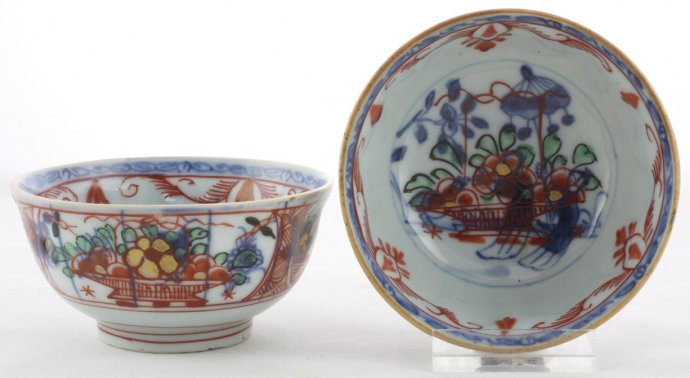
Sold Ceramics - Sold Chine de commande - Western Subjects 1680-1800 - Western Designers -
Page 1
Pronk, Cornelis (1691-1759)
Objects 2011269 & 2011270
A pair of small bowls
China
1730-1740, over-decorated in the Netherlands, c.1740-1745.
2010269: height 44 mm (2.56 inch), diameter of rim 84 mm (5.00 inch), diameter of footring 40 mm (2.44 inch)
2010270: height 42 mm (2.56 inch), diameter of rim 85 mm (5.00 inch), diameter of footring 39 mm (2.44 inch)
A pair of moulded bowls on footrings with straight underglaze brown-edged rims (jia mangkou). Decorated in underglaze blue with the 'Parasol Lady' after a design by the Dutch artist Cornelis Pronk (1691-1759) with a lady besides the water's edge with reeds, gesturing towards three birds on the ground in front of her, and her maid holding an ornate parasol. Overdecorated. in various overglaze enamels, iron-red, black and gold in The Netherlands, Amsterdams Bont c.1740-1745 with on the outside four panels, two filled with a basket filled with flowering plants, hanging ribbons and flying insects, the other two with a fisherman at a riverbank. Around the foot three concentric bands. The bottom is overdecorated with a basket filled with flowering plants, hanging ribbons and two flying insects. Round the inside rim an ornamental border.
Pronk´s the ´Parasol Lady´ desgn became very fashionable and was still in great demand when Dutch East India Company, (Vereenigde Oost-Indische Compagnie, VOC) orders for this type of porcelain declined. Simplified imitations soon appeared on the market made at the artists' initiative, where both early Chinese and Japanese versions were used as models. These bowls are an example of such a late Chinese variant.
This type of over-decorated Chinese and Japanese porcelain was called Amsterdams Bont in 18th-century Holland and varied greatly in quality. Little is known about the workshops where the overdecorating occurred. (Jörg 2002/2, p.160) It has been stated that one of the reasons that Chinese and Japanese porcelains were clobbered was to hide existing imperfections. An interesting detail in this regard on object 2011269 is that the Amsterdams Bont decorator painted his decoration on the inner wall precisely over an already existing hairline, this way making it less visible.
Remarkably the original underglaze blue Chinese decoration of Pronk's 'Parasol Lady' has not been respected at all by the Amsterdams Bont decorator. This rather coarse overdecoration in only a few colours of a basket of flowers with insects and the fisherman and a sentry house characterises most Amsterdams Bont over-decorated objects.
This underglaze blue representation of the 'Parasol Lady' over-decorated in Amsterdams Bont is extremely rare. Not a single object with this combination of a Pronk's design overdecorated in Amsterdams Bont is recorded thus far.
Condition:
2011269: A fleabite, a frit and a hairline to the rim.
2011270: Perfect.
References:
Goldsmith Phillips 1956, cat. 33
Lunsingh Scheurleer 1966, cat. 185
Howard & Ayers 1978, vol. I, pp.292-296
Jörg 1982/1, cat. 31-35 & cat. 40
Lunsingh Scheurleer 1989, cat. 182
Howard 1994, cat. 53 & cat. 57
Jörg & Van Campen 1997, cat. 328a/b & cat. 329 & 390
Jörg 2002/2, cat. 98, 99 & 113
Donated to the collection Oriental ceramics of the Groninger Museum, Groningen, The Netherlands.
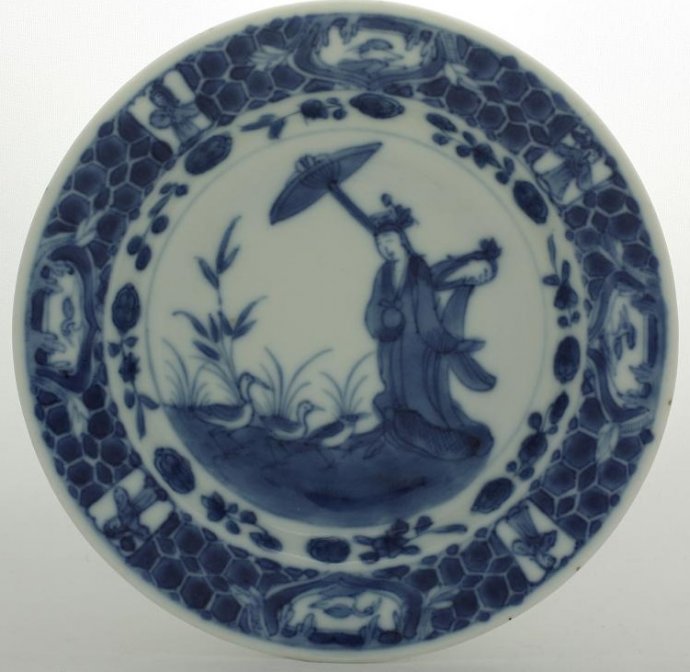
Sold Ceramics - Sold Chine de commande - Western Subjects 1680-1800 - Western Designers -
Page 1
Pronk, Cornelis (1691-1759)
Object 2010190
Saucer
China
1740-1745
Height 15 mm (0.59 inch), diameter of rim 132 mm (5.19 inch), diameter of footring 65 mm (2.56 inch)
Small deep saucer on footring, flat rim. Decorated in underglaze blue with with the 'Parasol Lady' after a design by the Dutch artist Cornelis Pronk (1691-1759) with two women by a reed border at a riverbank, one holding a parasol, the other watching three wadingbirds. On the sides a narrow band with flower sprays alternating with flower heads. Round the rim a honeycomb pattern, separated by eight panels with a paddling bird alternating with a lady holding a parasol. On the reverse seven insects.
As mentioned Pronk's design of the 'Parasol Lady' was also used on Japanese porcelain. It was not ordered by the Dutch East India Company, (Vereenigde Oost-Indische Compagnie, VOC) but commissioned by private Dutch traders. On Japanese pieces, the Chinese ladies have become Japanese with their characteristic hairstyles and kimonos. Pronk designs were still in great demand, particularly the Parasol Lady, when VOC orders for this type of porcelain declined. Simplified versions were made at the artists' initiative, where both early Chinese and Japanese versions were used as models. This is one such late Chinese variant in Japanese style. Only deep, blue saucers of this Chinese variation on a Japanese style are known in four increasing sizes, for a saucer with a diameter of 156 mm (6.14 inch) please see; Jörg 2002/2, pp.144-145, cat. 99. The body, the glaze and the cobalt blue are unmistakably Chinese. (Jörg corrects an earlier erroneous Japanese attribution based on the Japanese decorative style in his catalogue of 1980. (Jörg 2002/2, pp.144-145, cat. 99)
For identically decorated saucers with the Chinese variant in Japanese style of Pronk's design the 'Parasol Lady', please see:
- Pronk porselein. Porselein naar ontwerpen van Cornelis Pronk / Pronk Porcelain. Porcelain after designs by Cornelis Pronk, (C.J.A. Jörg, exhibition catalogue, Groninger Museum / Haags Gemeentemuseum, Groningen, 1980), p.71 cat. 34 & p.73, cat V.
- 'De Parasoldame', C.J.A. Jörg in Kunstschrif, 1996-5, Den Haag, september / oktober 1996, pp.38-44, fig. 85.
- Jan Menze van Diepen Stichting. Selectie uit de collectie Oosterse keramiek. (Jan Menze van Diepen Foundation. A Selection from the Collection of Oriental Ceramics), (C.J.A. Jörg, Slochteren, 2002), pp.144-145, cat. 99.
Condition: Two very very tiny pots on the rim, caused by a popped bubble of glaze during the firing process.
References:
Goldsmith Phillips 1956, cat. 33
Lunsingh Scheurleer 1966, cat. 185
Howard & Ayers 1978, vol. I, pp.292-296
Jörg 1982/1, cat. 31-35 & cat. 40
Lunsingh Scheurleer 1989, cat. 182
Howard 1994, cat. 53 & cat. 57
Jörg & Van Campen 1997, cat. 328a/b & cat. 329
Price: Sold.
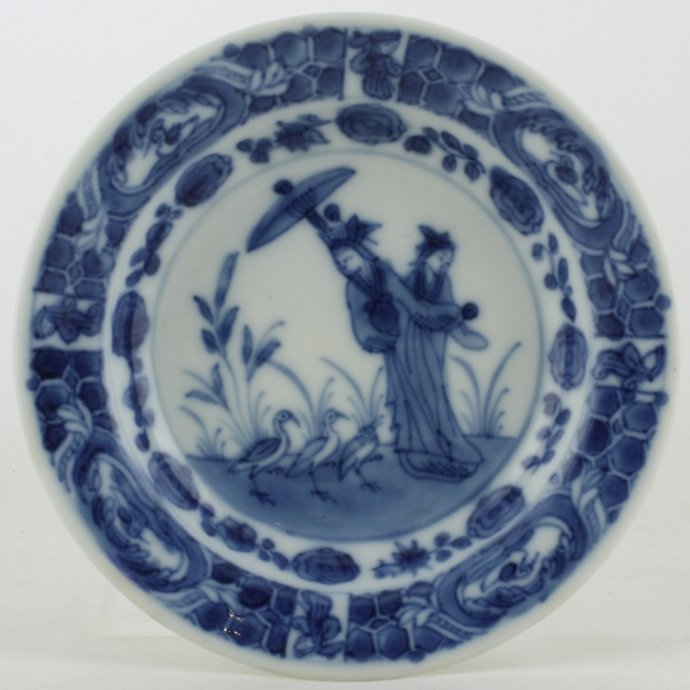
Sold Ceramics - Sold Chine de commande - Western Subjects 1680-1800 - Western Designers -
Page 1
Pronk, Cornelis (1691-1759)
Object 2011964
Small saucer
China
1740-1745
Height 22 mm (0.87 inch), diameter of rim 113 mm (4.45 inch), diameter of footring 58 mm (2.28 inch), weight 79 grams (2.79 ounce (oz.))
Small deep saucer on footring, flat rim. Decorated in underglaze blue with two women by a reed border at a riverbank, one holding a parasol, the other watching three wadingbirds. On the sides a narrow band with flower sprays alternating with flower heads. Round the rim a honeycomb pattern, separated by eight panels with a paddling bird alternating with a lady holding a parasol. On the reverse seven insects.
As mentioned Pronk's design of the 'Parasol Lady' was also used on Japanese porcelain. It was not ordered by the Dutch East India Company, (Vereenigde Oost-Indische Compagnie, VOC) but commissioned by private Dutch traders. On Japanese pieces, the Chinese ladies have become Japanese with their characteristic hairstyles and kimonos. Pronk designs were still in great demand, particularly the Parasol Lady, when VOC orders for this type of porcelain declined. Simplified versions were made at the artists' initiative, where both early Chinese and Japanese versions were used as models. This is one such late Chinese variant in Japanese style. Only deep, blue saucers of this Chinese variation on a Japanese style are known in four increasing sizes, for a saucer with a diameter of 156 mm (6.14 inch) please see;
- Jan Menze van Diepen Stichting. Selectie uit de collectie Oosterse keramiek. (Jan Menze van Diepen Foundation. A Selection from the Collection of Oriental Ceramics), (C.J.A. Jörg, Slochteren, 2002), pp.144-145, cat. 99. Jörg 2002/2, pp.144-145, cat. 99
for a saucer with a diameter of 132 mm (5.31 inch) please see;
The body, the glaze and the cobalt blue are unmistakably Chinese. (Jörg corrects an earlier erroneous Japanese attribution based on the Japanese decorative style in his catalogue of 1980. (Jörg 2002/2, pp.144-145, cat. 99)
For identically decorated saucers with the Chinese variant in Japanese style of Pronk's design the 'Parasol Lady', please see:
- Pronk porselein. Porselein naar ontwerpen van Cornelis Pronk / Pronk Porcelain. Porcelain after designs by Cornelis Pronk, (C.J.A. Jörg, exhibition catalogue, Groninger Museum / Haags Gemeentemuseum, Groningen, 1980), p.71 cat. 34 & p.73, cat V.
- 'De Parasoldame', C.J.A. Jörg in Kunstschrif, 1996-5, Den Haag, september / oktober 1996, pp.38-44, fig. 85.
- Jan Menze van Diepen Stichting. Selectie uit de collectie Oosterse keramiek. (Jan Menze van Diepen Foundation. A Selection from the Collection of Oriental Ceramics), (C.J.A. Jörg, Slochteren, 2002), pp.144-145, cat. 99.
- Sold Ceramics - Sold Chine de commande - Western Subjects 1680-1800 - Western Designers - Pronk, Cornelis (1691-1759) - Object 2010190.
Condition: Some firing flaws, a hairline and some professionally restored frits and and chips to the rim.
References:
Goldsmith Phillips 1956, cat. 33
Lunsingh Scheurleer 1966, cat. 185
Howard & Ayers 1978, vol. I, pp.292-296
Jörg 1982/1, cat. 31-35 & cat. 40
Lunsingh Scheurleer 1989, cat. 182
Howard 1994, cat. 53 & cat. 57
Jörg & Van Campen 1997, cat. 328a/b & cat. 329
Price: Sold.
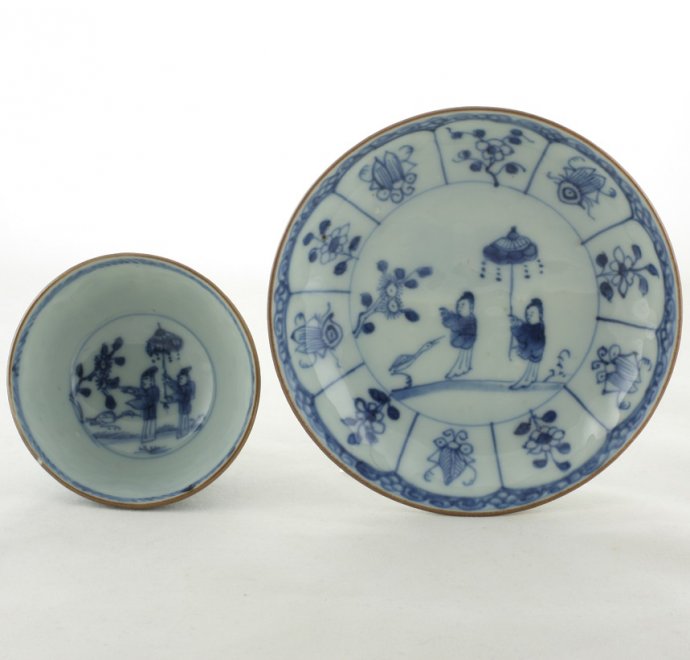
Sold Ceramics - Sold Chine de commande - Western Subjects 1680-1800 - Western Designers -
Page 1
Pronk, Cornelis (1691-1759)
Object 2011527
Teacup and saucer
China
1736-1740
Height of teacup 42 mm (1.65 inch), diameter of rim 72 mm (2.84 inch), diameter of footring 31 mm (1.22 inch), weight 61 grams (2.15 ounce (oz.))
Height of saucer 27 mm (1.06 inch), diameter of rim 117 mm (4.61 inch), diameter of footring 69 mm (2.72 inch), weight 88 grams (3.10 ounce (oz.))
A moulded teacup and saucer on footrings with straight underglaze brown-edged rims (jia mangkou). Decorated in underglaze blue with a simplified representation of the the 'Parasol Lady' after a design by the Dutch artist Cornelis Pronk (1691-1759) with two women by a reed border at a riverbank, one holding a parasol, the other watching a bird. On the sides panels filled with insects alternating with flowering plants. The reverse is undecorated. The teacup is decoraed en suite.
Pronk´s the ´Parasol Lady´ desgn became very fashionable and was still in great demand when Dutch East India Company, (Vereenigde Oost-Indische Compagnie, VOC) orders for this type of porcelain declined. Simplified imitations soon appeared on the market made at the artists' initiative, where both early Chinese and Japanese versions were used as models. This teacup and saucer are an example of such a late Chinese variant.
For a similarly decorated teacup / saucer, please see:
Condition:
Teacup: A frit to the rim.
Saucer: Perfect.
References:
Goldsmith Phillips 1956, cat. 33
Lunsingh Scheurleer 1966, cat. 187
Howard & Ayers 1978, vol. I, pp.292-296
Jörg 1982/1, cat. 31-35 & cat. 40
Lunsingh Scheurleer 1989, cat. 182
Wästefelt et al. 1991, pp. 270-273
Howard 1994, cat. 53 & cat. 57
Jörg & Van Campen 1997, cat. 328a/b & cat. 329
Sargent 2012, p.183 & cat. 143
Price: Sold.

Sold Ceramics - Sold Chine de commande - Western Subjects 1680-1800 - Western Designers -
Page 1
Pronk, Cornelis (1691-1759)
Object 201098
Saucer
China
1750-1775
Height 19 mm (0.75 inch), diameter of rim 110 mm (4.33 inch), diameter of footring 65 mm (2.44 inch), weight 55 grams (1.94 ounce (oz.))
Saucer on footring with straight sides. Decorated in underglaze blue with a simplified representation of the 'Parasol Lady' after a design by the Dutch artist Cornelis Pronk (1691-1759) with a lady besides the water's edge with reeds, gesturing towards two birds on the ground in front of her, and her maid holding an ornate parasol. Round the rim a trellis pattern border with four reserves filled with flower heads. The reverse is undecorated.
Pronk´s the ´Parasol Lady´ desgn became very fashionable and was still in great demand when Dutch East India Company, (Vereenigde Oost-Indische Compagnie, VOC) orders for this type of porcelain declined. Simplified imitations soon appeared on the market made at the artists' initiative, where both early Chinese and Japanese versions were used as models. This saucer is an example of such a late Chinese variant.
Shards of a similar decorated saucer were excavated from the wreck of the Swedish East Indiaman Götheborg that ran aground and sunk in 1745 less than a kilometre short of her home port. (Wästefelt et al. 1991, pp. 270-273) For this shard of an identically decorated saucer, please see:
For similarly decorated teacups and saucers, please see:
- Pronk porselein. Porselein naar ontwerpen van Cornelis Pronk / Pronk Porcelain. Porcelain after designs by Cornelis Pronk, (C.J.A. Jörg, exhibition catalogue, Groninger Museum / Haags Gemeentemuseum, Groningen, 1980), p.69 cat. 27.
- 'De Parasoldame', C.J.A. Jörg in Kunstschrif, 1996-5, Den Haag, september / oktober 1996, pp.38-44, fig. 89.
- Kostbaar Goed van Grote Pracht. Chinees en Japans exportporselein uit de 17e en 18e eeuw, (Mr. L.C.A.M. Schölvinck, Zwolle 2010), p.54.
Condition: Two glaze frits, one to the front and one to the back of the rim, and four tiny fleabites to the reverse rim only visible at the reverse.
References:
Goldsmith Phillips 1956, cat. 33
Lunsingh Scheurleer 1966, cat. 187
Howard & Ayers 1978, vol. I, pp.292-296
Jörg 1982/1, cat. 31-35 & cat. 40
Lunsingh Scheurleer 1989, cat. 182
Wästefelt et al. 1991, pp. 270-273
Howard 1994, cat. 53 & cat. 57
Jörg & Van Campen 1997, cat. 328a/b & cat. 329
Price: Sold.
More pictures of object 2010313, another identically shaped, sized and decorated, sold saucer >>

Sold Ceramics - Sold Chine de commande - Western Subjects 1680-1800 - Western Designers -
Page 1
Pronk, Cornelis (1691-1759)
Objects 201097
Tea bowl
China
1750-1775
Height 49 mm (1.93 inch), diameter of rim 73 mm (2.87 inch), diameter of footring 33 mm (1.29 inch), weight 65 grams (2.29 ounce (oz.))
Tea bowl on footring, straight underglaze brown-edged rim (jia mangkou). Decorated in underglaze blue with a simplified representation of the 'Parasol Lady' after a design by the Dutch artist Cornelis Pronk (1691-1759) with a lady besides the water's edge with reeds, gesturing towards three birds on the ground in front of her, and her maid holding an ornate parasol. Round the inner rim a trellis pattern border.
Pronk´s the ´Parasol Lady´ design became very fashionable and was still in great demand when Dutch East India Company, (Vereenigde Oost-Indische Compagnie, VOC) orders for this type of porcelain declined. Simplified imitations soon appeared on the market made at the artists' initiative, where both early Chinese and Japanese versions were used as models. This tea bowl is an example of such a late Chinese variant.
For the Dutch East India Company, (Vereenigde Oost-Indische Compagnie, VOC) porcelain made to order after the drawings by Cornelis Pronk proved not to be profitable enough. Private traders however, saw how well it sold, which prompted them to commission simplified versions. This was the beginning of the production of all sorts of blue and coloured versions of this ware, among others of tea ware and of plates. Quite extraordinary were the Japanese imitations of Pronk Porcelain, which featured Japanese geishas instead of the well-known Chinese parasol ladies. This variant was later in turn copied in China as well. After it arrived in the Netherlands, blue Chinese porcelain was occasionally over-decorated in enamel colours (Amsterdams Bont), whereby the Pronk motif was copied as well. English imitations were seen far into the 19th century, while this motif even appears to have still been applied on Maastricht ware of as late approximately 1900. (Source: Groninger Museum)
Shards of a similar decorated saucer were excavated from the wreck of the Swedish East Indiaman Götheborg that ran aground and sunk in 1745 less than a kilometre short of her home port. (Wästefelt et al. 1991, pp. 270-273) For this shard of an identically decorated saucer, please see:
For a similarly decorated tea bowl / saucer, please see:
- Pronk porselein. Porselein naar ontwerpen van Cornelis Pronk / Pronk Porcelain. Porcelain after designs by Cornelis Pronk, (C.J.A. Jörg, exhibition catalogue, Groninger Museum / Haags Gemeentemuseum, Groningen, 1980), p.69 cat. 27.
- 'De Parasoldame', C.J.A. Jörg in Kunstschrif, 1996-5, Den Haag, september / oktober 1996, pp.38-44, fig. 89.
Condition: Some unglazed spots to the bottom, caused by the firing process.
References:
Goldsmith Phillips 1956, cat. 33
Lunsingh Scheurleer 1966, cat. 185
Howard & Ayers 1978, vol. I, pp.292-296
Jörg 1982/1, cat. 31-35 & cat. 40
Lunsingh Scheurleer 1989, cat. 182
Wästefelt et al. 1991, pp. 270-273
Howard 1994, cat. 53 & cat. 57
Jörg & Van Campen 1997, cat. 328a/b & cat. 329
Price: Sold.
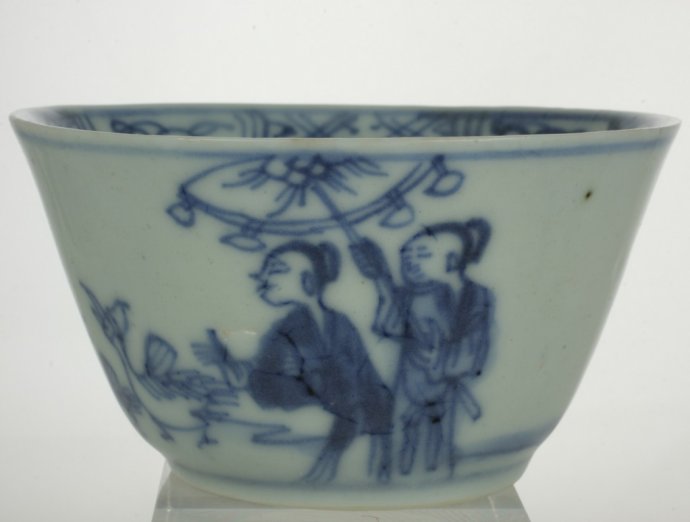
Sold Ceramics - Sold Chine de commande - Western Subjects 1680-1800 - Western Designers -
Page 1
Pronk, Cornelis (1691-1759)
Objects 2010478
Teacup
China
1750-1775
Height 40 mm (1.57 inch), diameter of rim 75 mm (2.95 inch), diameter of footring 40 mm (1.57 inch), weight 46 grams (1.62 ounce (oz.))
Teacup on footring, slightly flaring rim. Decorated in underglaze blue with a simplified representation of the 'Parasol Lady' after a design by the Dutch artist Cornelis Pronk (1691-1759) with a lady besides the water's edge with reeds, gesturing towards two birds on the ground in front of her, and her maid holding an ornate parasol. Round the inner rim a trellis pattern border with four reserves filled with flower heads.
Pronk´s the ´Parasol Lady´ desgn became very fashionable and was still in great demand when Dutch East India Company, (Vereenigde Oost-Indische Compagnie, VOC) orders for this type of porcelain declined. Simplified imitations soon appeared on the market made at the artists' initiative, where both early Chinese and Japanese versions were used as models. This saucer is an example of such a late Chinese variant.
Shards of a similar decorated saucer were excavated from the wreck of the Swedish East Indiaman Götheborg that ran aground and sunk in 1745 less than a kilometre short of her home port. (Wästefelt et al. 1991, pp. 270-273) For this shard of an identically decorated saucer, please see:
For a similarly decorated teacup / saucer, please see:
- Pronk porselein. Porselein naar ontwerpen van Cornelis Pronk / Pronk Porcelain. Porcelain after designs by Cornelis Pronk, (C.J.A. Jörg, exhibition catalogue, Groninger Museum / Haags Gemeentemuseum, Groningen, 1980), p.69 cat. 27.
- 'De Parasoldame', C.J.A. Jörg in Kunstschrif, 1996-5, Den Haag, september / oktober 1996, pp.38-44, fig. 89.
Condition: Two consolidated hairlines to the rim and a restored chip to the rim.
References:
Goldsmith Phillips 1956, cat. 33
Lunsingh Scheurleer 1966, cat. 185
Howard & Ayers 1978, vol. I, pp.292-296
Jörg 1982/1, cat. 31-35 & cat. 40
Lunsingh Scheurleer 1989, cat. 182
Wästefelt et al. 1991, pp. 270-273
Howard 1994, cat. 53 & cat. 57
Jörg & Van Campen 1997, cat. 328a/b & cat. 329
Price: Sold.


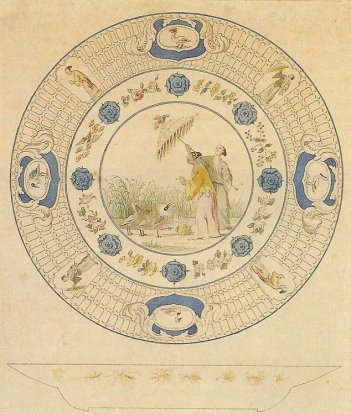

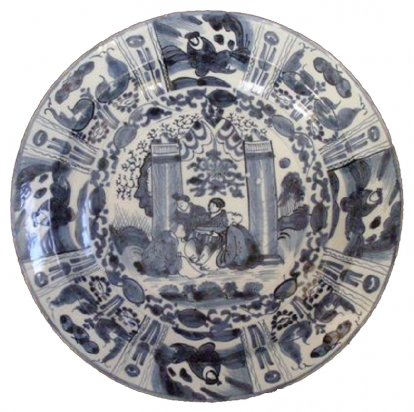

 create websites
create websites